A new report on the state of the solar industry in America indicates that despite a global oversupply and a potential trade war with China, the U.S. solar industry had its second-best quarter ever in terms of installations, during the first quarter of 2012.
The number of installations, 506 megawatts worth, enough to power just over 350,000 homes, was bested only by the fourth quarter of 2011, which saw a whopping 708 megawatts worth of solar installed.
On top of that, the report, drafted by clean-energy market analysis firm GTM Research and the Solar Energy Industries Association and released Tuesday, a trade group, forecasts that total U.S. installed solar power will increase 75 percent his year alone, with 3.3 gigawatts-worth of solar power installed, compared to the 4.4 gigawatts that are currently installed in the country and were added over years of development.
“This will be by far the largest year we’ve ever had for solar in the U.S.,” said Shayle Kann, vice president of research at GTM, in a phone interview with TPM. “Relative to expectations, the first quarter was very strong. We saw both the commercial and residential markets grow.”
Indeed, commercial solar installations, those put in place on corporate properties, accounted for the overwhelming majority’s worth of solar power installed in the quarter — 288.8 megawatts, according to the GTM and SEIA U.S. Solar Market Insight report.
Furthermore, residential power installations (those installed on homes) accounted for 93.9 megawatts. The final category, utilities power installations, or solar put in place by power companies, accounted for 123.6 megawatts of installations, but that number was actually a steep decline from both the third and fourth quarters of 2011.
However, as the report points out, “direct comparisons between these two quarters [fourth and first] carry little meaning,” because “construction timelines for a relatively few large projects can cause large swings from quarter to quarter more than any underlying market dynamics.”
In essence: The natural construction cycle for solar projects and other power installations, governed by weather and the fiscal year, means that generally, utilities won’t be installing solar panels in larger numbers until later in the year, so long as they have those projects already lined up, “in the pipeline,” as it were.
“The pipeline is still huge,” Kann told TPM.
Intriguingly, when it came to the state-by-state breakdown for solar installations for the first quarter of 2012, New Jersey lead the nation in solar installations, with a whopping 173.8 megawatts of solar power generation capacity installed in the three month period. California, more commonly associated with solar, was second with 148.4 megawatts.
“New Jersey has been a leader in solar for years thanks to good state level policy,” Kann explained, “That’s the most important thing.”
Kann pointing to the state’s Solar Renewable Energy Certificates (SREC) program, which allows solar installation owner to sell credits on a competitive state market, credits earned for every 1,000 kilowatt-hours of electricity every single project generates. He said that other states were wise to follow in New Jersey’s path.
At the same time, domestic solar manufacturing took a hit as prices for some solar panel arrays plummeted by 47 percent over the same quarter last year.
The manufacturing downturn was taken as proof positive by the Coalition For Solar Manufacturing, a trade grouped formed specifically to petition the U.S. government to slap tariffs on Chinese imports of cheap solar panels, which the group says were illegally subsidized and dumped. The Commerce Department did find some Chinese companies guilty of illegally subsidizing and dumping, and did end up imposing tariffs.
As Gordon Brisner, president of SolarWorld America, the lead company in CASM, said in a statement distributed to reporters this week: “The sharp drop in U.S. solar manufacturing, even as demand in the United States grows, is powerful evidence of injury caused by unfair Chinese trade practices.”
Kann said that just because there was a global oversupply of solar panels driving down the price didn’t mean that China was necessarily dumping, though.
“Manufacturers across the globe didn’t prepare well,” Kann told TPM. “They kept producing even when their inventory was really high, which lead to a drastic market correction,” i.e., the falling price of solar panel modules.
Still, Kann said that the overall picture of the U.S. solar industry remained bright.
“We’re expecting see growth in all three sectors: residential, commercial and utilities,” Kann added.






